#41st regiment of foot
Explore tagged Tumblr posts
Text
By this time the 41st Regiment was in a very poor state. All were at least six months in arrears of pay and lacked greatcoats or blankets against the approaching autumn weather; with a growing sick list they had not eaten properly for two days and now stood waiting for three hours, shuffled and reshuffled by Proctor, so that, as Ensign James Cochran noted, "the order of the lines was neither extended nor close but somewhat irregularly between both, and the trees were rather of a late growth but not sufficiently large to afford protection to the numbers that crowded behind them."
— Jon Latimer on the Battle of the Thames in 1812: War with America.

Illustration by Peter Denis for The Thames 1813, depicting the 41st Regiment of Foot against the charge of Lieutenant-Colonel James Johnson's horsemen.
#war of 1812#battle of the thames#military history#41st regiment of foot#kentucky mounted infantry volunteers#redcoats#dressed to kill#yes it's one of the johnson brothers#fellas do you ever feel very sad and conflicted about the battle of the thames#a lot of sympathy for all sides in the conflict#also it's hard to find battle of the thames pictures that aren't just glorifying the americans#canadian history
11 notes
·
View notes
Note
hello! i’m looking into adopted yet another 19th century man. i’ve owned several others, and am looking for something unique. are there any unique and peculiar breeds you recommend?
Sure! These heritage and unique 19th century men may not be for everyone, but I want them to get more love.
French soldier left behind on the field of battle during the 1870 Franco-Prussian War.
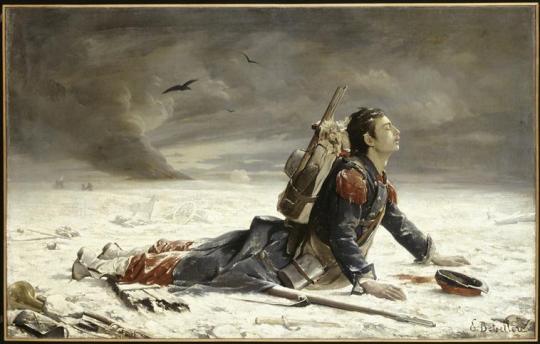
Poor sweetheart!! True story: the model for this 1872 painting, real French soldier Théodore Larran, met the artist Émile Betsellère many times because Betsellère was so touched by his story. Absolutely the type of 19th century man you want to rescue and love.
A jolly flatboatman.
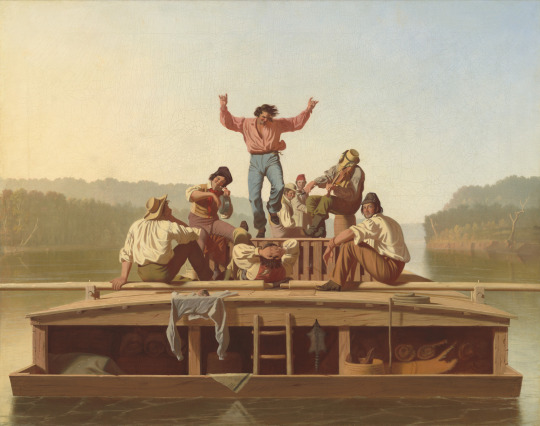
From The Jolly Flatboatmen by artist George Caleb Bingham, 1846.
A good 19th century man doesn't have to be wealthy or formal, as these charming working class fellows attest. Perfect for the aficionado of lively, active 19th century men.
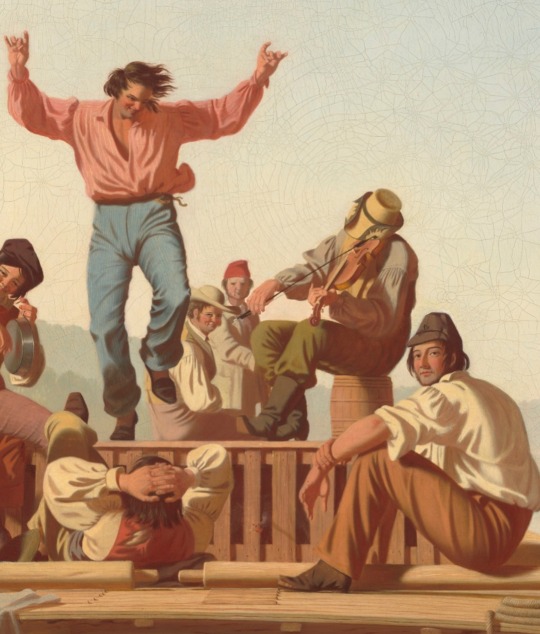
British Army 41st Regiment of Foot Soldier, c. 1800-1815.
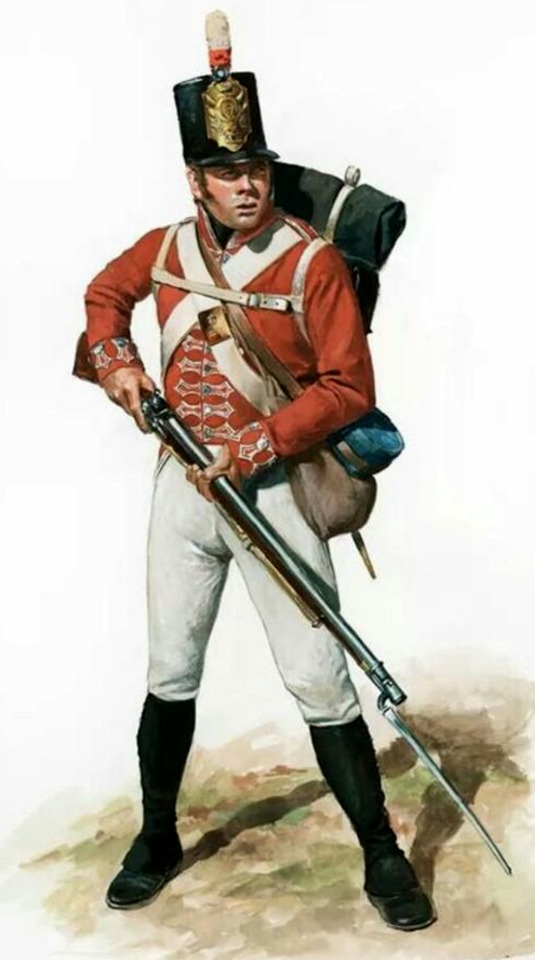
Who doesn't have "a passion for a scarlet coat," as Jonathan Swift phrased it! Your soldier needs a lot of exercise and structure, but he's not picky about his food or bedding. Comes with his own blanket and water bottle! He's a lover, he's a fighter, I recommend delousing him before you bring him into your home.
Cossack Trowsers King.
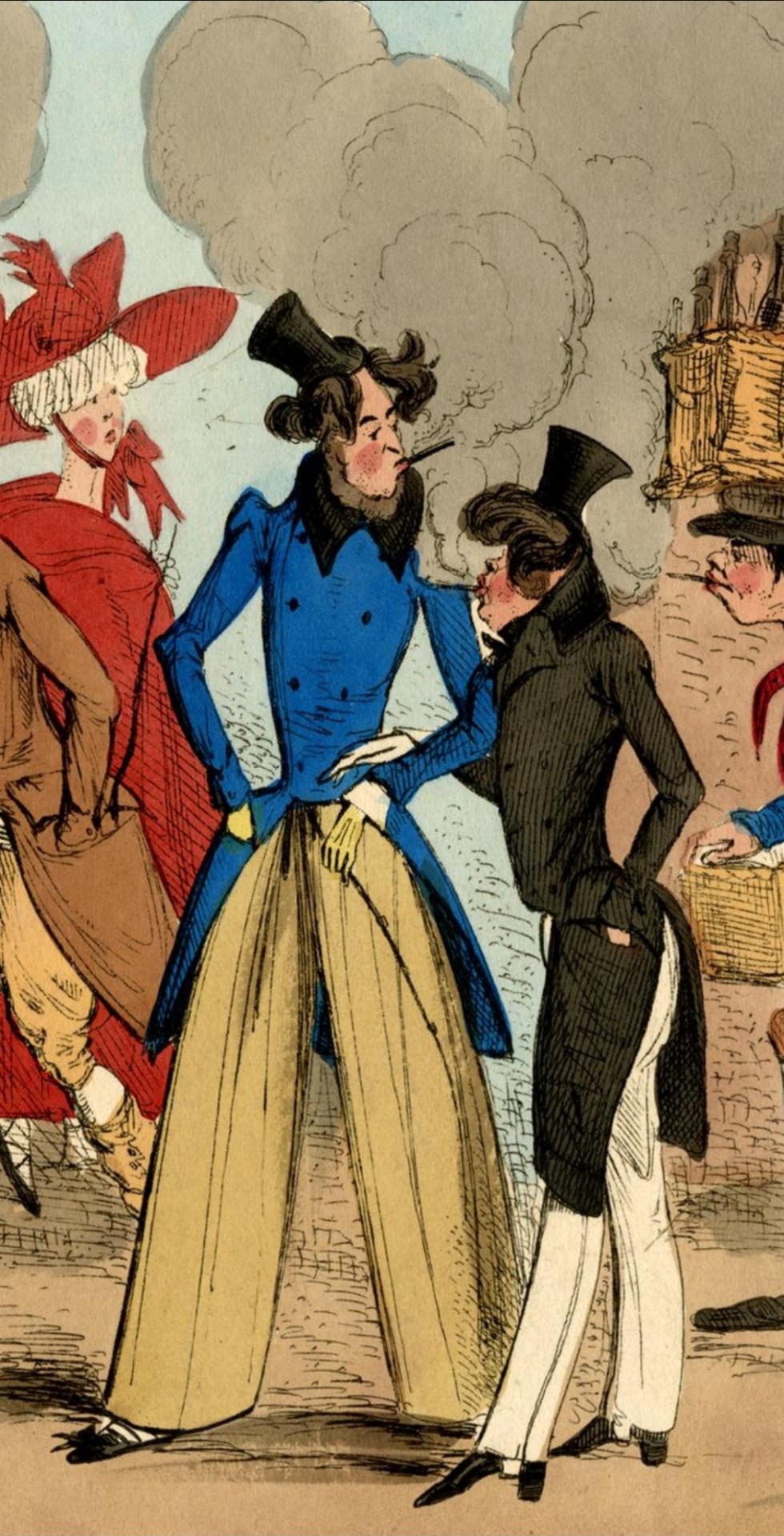
Strutting his stuff in 1827, he has an insouciant attitude and a bold, fashion-forward look. You may want to address the fact that he's also a major source of air pollution.
178 notes
·
View notes
Text
THIS DAY IN GAY HISTORY
based on: The White Crane Institute's 'Gay Wisdom', Gay Birthdays, Gay For Today, Famous GLBT, glbt-Gay Encylopedia, Today in Gay History, Wikipedia, and more … November 30

November 30 Holidays


1554 – Sir Philip Sidney, English courtier, soldier, and writer (d.1586); the English courtier and poet was one of the leading lights of Queen Elizabeth's court and a model of Renaissance chivalry. His Apostrophel and Stella is one of the great sonnet sequences in English and was inspired by his love for Penelope Devereaux, even though he later married Frances Walsingham. Lest one confuse Renaissance "love" and "marriage" with the modern versions, it should be pointed out that Penelope Devereaux was 12-years old when Sidney fell in love with her, and that Frances Walsingham was 14 when she was married to the 29-year-old courtier. Marriages were arranged then and not made in heaven, more a real estate transaction than a spiritual love match.
Sidney, himself, was in his teens when the Huguenot writer and diplomat Hubert Languet fell in love with him. Languet was 36 years his senior, lived with him for a time, and, when they parted, wrote passionate letters to him weekly. In his youth, Sidney was strongly attached to two young men, Fulke Greville and Edward Dyer, and wrote love verses to them both, a point not lost on gay John Addington Symonds when he wrote Sidney's biography.
Sidney died in battle at the age of 32. According to the story, while lying wounded he gave his water-bottle to another wounded soldier, saying, "Thy necessity is yet greater than mine". This became possibly the most famous story about Sir Phillip, intended to illustrate his noble character.


1624 – In the Virginia Colony, Richard Cornish was hanged for sodomy for allegedly making advances on an indentured servant, William Couse. His conviction and execution, angrily contested by his brother and others, is the first to be recorded in the American colonies. In 1993 the William and Mary Gay and Lesbian Alumni created the Richard Cornish Endowment Fund for Gay and Lesbian Resource.


1864 – Died: Major General Patrick (Ronayne) Cleburne (b.1828), who was an Irish American soldier, best known for his service in the Confederate States Army during the American Civil War. Born in County Cork, Ireland, Cleburne served in the 41st Regiment of Foot of the British Army after failing to gain entrance into Trinity College of Medicine in 1846. He emigrated to the U.S. three years later. At the beginning of the Civil War, Cleburne sided with the Confederacy. He progressed from being a private soldier in the local militia to a division commander. Cleburne participated in many successful military campaigns, especially the Battle of Stones River and the Battle of Ringgold Gap. His strategic ability gained him the nickname "Stonewall of the West".
According to Randy Shilts ("Conduct Unbecoming"), the Major General might have earned the "Stonewall" appellation for less martial reasons. According to Shilts in his bestselling Conduct Unbecoming the Major General was a 'life-long bachelor' and wrote of the great love of his life:
Cleburne's relationship with his twenty-two year old adjutant, Captain Irving Ashby Buck, drew the notice of the general's colleagues. Cleburne's biographer John Francis Maguire wrote that the general's 'attachment' to Buck 'was a very strong one' and that Buck 'for nearly two years of the war, shared Cleburne's labors during the day and his blankets at night.' Buck himself wrote that the pair were 'close and confidential. I habitually messed with him and shared his tent and often his blankets."
Prior to the campaigning season of 1864, Cleburne became engaged to Susan Tarleton of Mobile, Alabama. Their marriage was never to be, as Cleburne was killed during an ill-conceived assault (which he opposed) on Union fortifications at the Battle of Franklin, just south of Nashville, Tennessee, on November 30, 1864.


Self-portrait
1869 – Konstantin Somov (d.1939) Russian Artist associated with the Mir iskusstva. He was the son of a curator at the Hermitage, and he attended the St Petersburg Academy of Art from 1888 to 1897, studying under the Realist painter Il'ya Repin from 1894. Somov was homosexual, like many of the World of Art members.

Sleeping Nude
In 1897 and again in 18989 he went to Paris and attended the studios of Filippo Colarossi and of Whistler. Neither the Realism of his Russian teachers nor the evanescent quality of Whistler's art was reflected for long in Somov's work. He turned instead for inspiration to the Old Masters in the Hermitage and to works of contemporary English and German artists, which he knew from visits abroad and from the art journals.
Following the Russian Revolution, he emigrated to the United States, but found the country "absolutely alien to his art" and moved to Paris. He was buried at the Sainte-Genevieve-des-Bois Cemetery.


1874 – Winston Churchill, British prime minister and statesman (d.1965). He was Britain's wartime prime minister whose courageous leadership and defiant rhetoric fortified the English during their long struggle against Hitler's Germany. "I have nothing to offer but blood, toil, tears, and sweat," he stated upon becoming prime minister at the beginning of the war. He called Hitler's Reich a "monstrous tyranny, never surpassed in the dark, lamentable catalogue of human crime." Following the war, he coined the term "Iron Curtain" to describe the barrier between areas in Eastern Europe under Soviet control and the free West.
In his wonderfully entertaining and informative biography of W. Somerset Maugham, Ted Morgan tells how Maugham once asked Churchill whether it was true, as the statesman's mother had claimed, that he had had affairs with other young men in his youth.
"Not true!" Churchill replied. "But I once went to bed with a man to see what it was like."
The man turned out to be musical-comedy star, Ivor Novello.
"And what was it like?" asked Maugham.
"Musical" Churchill replied.
Another famous story goes that when Winston Churchill was Prime Minister, he was woken one freezing February morning by a Downing Street aide bearing the shocking news that a male Tory MP had been caught having sex with a naked guardsman in St James’s Park.
Noting that it had been the coldest night of the winter, Churchill is said to have remarked: "Makes you proud to be British."


1900 – On this date, Oscar Wilde, Irish writer, wit and raconteur died (b.1854); Prison, after his conviction for "gross indecency," was unkind to Wilde's health and after he was released on May 19, 1897 he spent his last three years penniless, in self-imposed exile from society and artistic circles. He went under the assumed name of Sebastian Melmoth, after the famously "penetrated" Saint Sebastian and the devilish central character of Wilde's great-uncle Charles Robert Maturin's gothic novel Melmoth the Wanderer.
Nevertheless, Wilde lost no time in returning to his previous pleasures. According to Lord Alfred Douglas, Robbie Ross "dragged [him] back to homosexual practices" during the summer of 1897, which they spent together in Berneval. After his release, he also wrote the famous poem The Ballad of Reading Gaol.
Wilde spent his last years in the Hôtel d'Alsace, now known as L'Hôtel, in Paris, where he was notorious and uninhibited about enjoying the pleasures he had been denied in England. Again according to Douglas, "he was hand in glove with all the little boys on the Boulevard. He never attempted to conceal it." In a letter to Ross, Wilde laments, "Today I bade good-bye, with tears and one kiss, to the beautiful Greek boy. . . he is the nicest boy you ever introduced to me."
Just a month before his death he is quoted as saying, "My wallpaper and I are fighting a duel to the death. One or other of us has got to go." His moods fluctuated; Max Beerbohm relates how, a few days before Wilde's death, their mutual friend Reginald 'Reggie' Turner had found Wilde very depressed after a nightmare. "I dreamt that I had died, and was supping with the dead!" "I am sure," Turner replied, "that you must have been the life and soul of the party." Reggie Turner was one of the very few of the old circle who remained with Wilde right to the end, and was at his bedside when he died. On his deathbed he was received into the Roman Catholic church. Wilde died of cerebral meningitis on November 30, 1900.
Wilde was buried in the Cimitiere de Bagneaux outside Paris but was later moved to Père Lachaise in Paris. His tomb in Père Lachaise was designed by sculptor Sir Jacob Epstein, at the request of Robert Ross, who also asked for a small compartment to be made for his own ashes. Ross's ashes were transferred to the tomb in 1950. The numerous spots on it are lipstick traces from admirers.
The modernist angel depicted as a relief on the tomb was originally complete with male genitals. They were broken off as obscene and kept as a paperweight by a succession of Père Lachaise cemetary keepers. Their current whereabouts are unknown. In the summer of 2000, intermedia artist Leon Johnson performed a forty minute ceremony entitled Re-membering Wilde in which a commissioned silver prosthesis was installed to replace the vandalized genitals.
Note: As a general rule, this site does not list persons' death dates - unless their death was something out of the ordinary, a reason for them to be remembered, or because we don't know their date of birth. However, Oscar Wilde desreves special treatment. His name is referenced in this collection of brief biographies far more than any other person. His life, trial, and death had a world-wide effect on gay history.


1924 – San Francisco police sergeant Elliott Blackstone (d.2006) was the first police officer in the nation assigned to work with the gay, lesbian, bisexual and transgender communities.
Elliott grew up in Chinook, MT. He graduated from Chinook High School (class of 1942) and immediately joined the United States Navy. He served in Naval Air in the Pacific Theater of World War II. He was honorably discharged in San Francisco, and made Northern California his home for the rest of his life.
He became a San Francisco police officer in 1949, serving until his retirement in 1975. As one of the City's ground-breaking Community Relations officers, he became the nation's first police liaison with the lesbian, gay, bi-sexual and transgender community and a tireless advocate for its individual members.
During his 26-year career with the San Francisco Police Department, Mr. Blackstone helped mend the rift between the gay, lesbian, bisexual and transgender community and the police department. Before his assignment in 1962, the department's previous interaction with the community largely involved raids on bars and entrapment of gay men in bathrooms.
"He didn't see any reason why homosexuality or cross-dressing should be illegal," said Susan Stryker, a historian and scholar who directed and produced a documentary, "Screaming Queens," which tells the story of a 1966 riot at Compton's Cafeteria in San Francisco's Tenderloin neighborhood. That event sparked San Francisco's transgender rights movement. After the riot, Mr. Blackstone trained other officers on transgender issues, and he is featured throughout the documentary.
The Pride Foundation of San Francisco named him Lifetime Achievement Grand Marshal for the 2006 Gay Pride Parade.


1955 – Kevin Conroy was an American actor and voice actor (d.2022). He is best known for his voice role as the DC Comics character Batman on the 1990s Warner Bros. television show Batman: The Animated Series, as well as various other TV series and feature films in the DC animated universe.
Due to the popularity of his performance as Batman, Conroy went on to voice the character for multiple films under the DC Universe Animated Original Movies banner, the critically acclaimed Batman: Arkham video games, and in fall 2019 he will play a live action Bruce Wayne in the Arrowverse adaptation of Crisis on Infinite Earths.
Conroy was born in Westbury, New York. Conroy was born into an Irish Catholic family which moved to Westport, Connecticut when he was about 11 years old. He moved to New York City in 1973 when he earned a full scholarship to attend Juilliard's drama division, studying under actor John Houseman. While there, he roomed with Robin Williams, who was in the same group as both Conroy and Kelsey Grammer.
After graduating from Juilliard in 1978, he toured with Houseman's acting group The Acting Company, and the following year he went on the national tour of Ira Levin's Deathtrap.
Filmreference.com listed Conroy as having been married, and having a child, though an interview with The New York Times in 2016 stated that he was single. He also said that he was gay.
In the 2016 interview with The New York Times promoting the animated adaptation of The Killing Joke, Conroy revealed that he was gay. As part of DC Comics' 2022 Pride anthology, Conroy wrote "Finding Batman", a story that recounted his life and experiences as a gay man. It received critical acclaim upon release. He was married to Vaughn C. Williams at the time of his death.
Conroy made an effort to conceal his homosexuality throughout most of his career. He spoke in "Finding Batman" about the discrimination he faced once potential collaborators and employers found out about his homosexuality. Conroy has said that on multiple occasions he had been removed from consideration for acting jobs due to his sexual orientation.


1978 – Born: Clay Aiken, American singer songwriter, actor, producer and author who began his rise to fame on the second season of the television program American Idol in 2003. Rolling Stone magazine featured Aiken on the cover of their July 2003 issue. In the cover article Aiken said, "One thing I've found of people in the public eye, either you're a womanizer or you've got to be gay. Since I'm neither one of those, people are completely concerned about me." In subsequent interviews he has expressed frustration over continued questions about his sexual orientation, telling People magazine in 2006, "It doesn't matter what I say. People are going to believe what they want."
After several years of public speculation, Aiken confirmed that he is gay in a September 2008 interview with People magazine. On November 18, 2010, Clay went to Washington, D.C. at a Capitol Hill briefing talking about anti-gay bullying.


1980 – Pepe Julian Onziema is an LGBT rights activist from Uganda. In 2012, he was named a Global Citizen by the Clinton Global Initiative for his work in human rights advocacy. He began his human rights work in 2003, which has twice led to his arrest. He has since participated in organizing gay pride celebrations in Uganda.
In 2012 he was invited to the Ugandan TV show Morning Breeze to join a debate about sexual minorities and their situation in Uganda. However the interview turned into a wild dispute when suddenly Martin Ssempa stormed into the show trying to discredit Onziema, waving fruits and vegetables while shouting in both English and Luganda over the moderator. The interview itself was uploaded to the internet and sparked internet memes.
In 2013, he was shortlisted for the David Kato Vision and Voice Award, an award in honour of his slain friend and colleague, and fellow advocacy officer for Sexual Minorities Uganda, David Kato.
In 2014, he was interviewed by John Oliver on the American television series Last Week Tonight about the human rights situation for LGBT people in Uganda. Stonewall selected Onziema as Hero of the Year in 2014.
Onziema initially identified as lesbian, and now lives as a trans man. He lives in Kampala.


2006 – South Africa is the first African country to legalize same-sex marriage.



Today's Gay Wisdom: The wit of Oscar Wilde
A cynic is a man who knows the price of everything but the value of nothing.
Moderation is a fatal thing. Nothing succeeds like excess.
There are only two kinds of people who are really fascinating: people who know absolutely everything, and people who know absolutely nothing.
To lose one parent, Mr Worthing, may be regarded as a misfortune; to lose both looks like carelessness.
We are all in the gutter, but some of us are looking at the stars.
An idea that is not dangerous is unworthy of being called an idea at all.
Education is an admirable thing, but it is well to remember from time to time that nothing that is worth knowing can be taught.
One should absorb the colour of life, but one should never remember its details. Details are always vulgar.
The truth is rarely pure and never simple.
Children begin by loving their parents; after a time they judge them; rarely, if ever, do they forgive them.
Experience is simply the name we give our mistakes.
Illusion is the first of all pleasures.
All bad poetry springs from genuine feeling.
It is better to be beautiful than to be good. But... it is better to be good than to be ugly.
There is nothing so difficult to marry as a large nose.
Keep love in your heart. A life without it is like a sunless garden when the flowers are dead.
Laughter is not at all a bad beginning for a friendship, and it is far the best ending for one.
There is only one thing in life worse than being talked about, and that is not being talked about.
Now that the House of Commons is trying to become useful, it does a great deal of harm.
The difference between literature and journalism is that journalism is unreadable and literature is not read.
Life imitates art far more than art imitates Life.
It's not whether you win or lose, it's how you place the blame.
The old believe everything, the middle-aged suspect everything, the young know everything.
America had often been discovered before Columbus, but it had always been hushed up.
There is no sin except stupidity.
It is only the modern that ever becomes old-fashioned.
A cigarette is the perfect type of a perfect pleasure. It is exquisite, and it leaves one unsatisfied. What more can one want?
Only the shallow know themselves.
Every saint has a past and every sinner has a future.
He hadn't a single redeeming vice.
A pessimist is one who, when he has a choice of two evils, chooses both.
Whenever people agree with me I always feel I must be wrong.


8 notes
·
View notes
Text

Grenadiers, 40th Regiment of Foot, and Privates, 41st Invalids Regiment and 42nd Highland Regiment, 1751
3 notes
·
View notes
Text
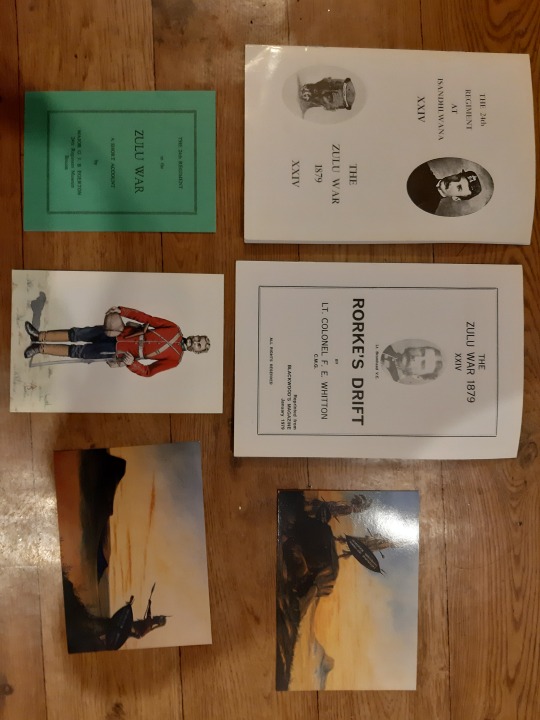

Came across some of my Zulu War info at my Mum's today from when I was a kid. The 24th Regiment at Isandhlwana, Rorke's Drift,The 24th Regiment in the Zulu War plus some nice post cards. One of which is an Officer 24th Foot (2nd Warwickshire Regiment). I also did an essay on the Zulu War when I was in primary school lol. There is no wondering why or how I got into Games Workshop's Praetorian Guard 🤣

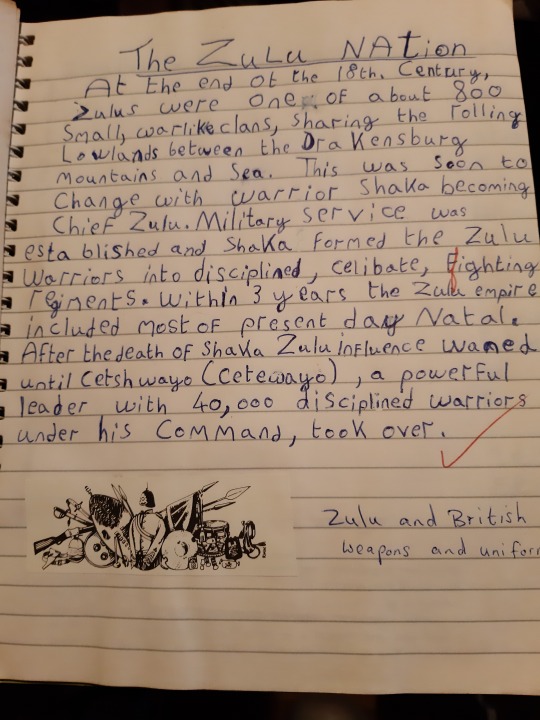
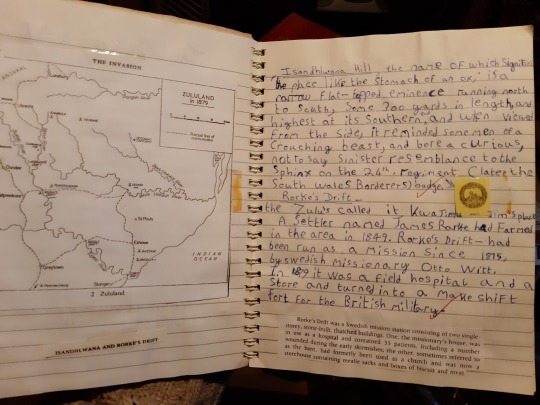
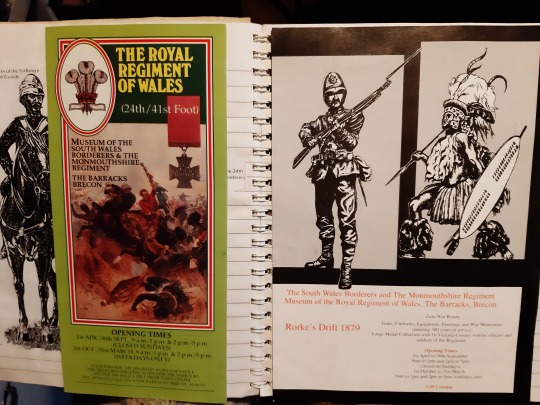
There are 30 pages of history and pictures. The research done for this was between Llanelli Library and Brecon Museum's in a time of No Internet! Lol. Imagine a kid today doing something like that? I must have been obsessed, I still am 🤣 I go back to the Royal Regiment of Wales museum almost every year. It helps when your Grandmother lives in Breacon.
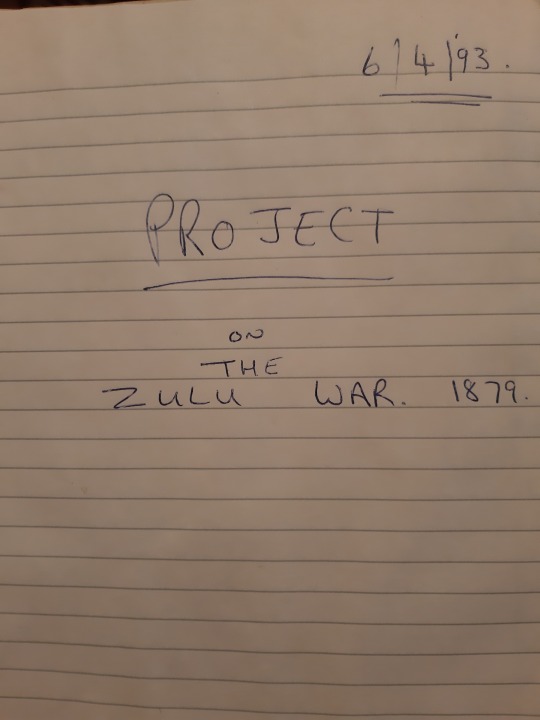
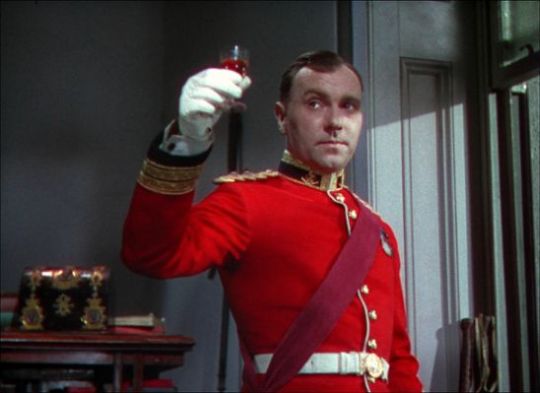
#the zulu war#zulu#24th foot#british army#history#praetorian guard#Royal Regiment of Wales#41st foot#1879
4 notes
·
View notes
Video
Fort George by David Via Flickr: Overlooking the Niagara River, Fort George was built between 1796 and 1802. This fortification served as the headquarters for the Centre Division of the British Army during the War of 1812, and played a pivotal role in the defence of Upper Canada.
#Canada#Fort George#Re-enactment#Living History#Uniform#Soldier#Army#Military#41st Regiment Infantry#outdoor#41st Regiment of Foot Fife and Drum Corps#41st Regiment of Foot Band of Music
13 notes
·
View notes
Text
Court Circular | 3rd February 2023
Buckingham Palace
The King was represented by Major General Christopher Elliott (formerly Colonel, The Royal Regiment of Wales, 24th/41st Foot) at the Funeral of Lieutenant Colonel Gordon Amphlett (formerly Regimental Sergeant Major, The Royal Regiment of Wales, 24th/41st Foot) which was held in Brecon Cathedral this afternoon. By command of The King, Mr Alistair Harrison (Marshal of the Diplomatic Corps) called upon His Excellency Mr Umit Yalcin at 43 Belgrave Square, London SW1, this morning in order to bid farewell to His Excellency upon relinquishing his appointment as Ambassador from the Republic of Türkiye to the Court of St James’s.
St James’s Palace
The Earl of Wessex, Patron, the Tennis and Rackets Association, this evening attended the Seacourt Silver Racquet Fiftieth Anniversary Dinner at Seacourt Tennis Club, 20 Victoria Avenue, Hayling Island, and was received by His Majesty’s Lord-Lieutenant of Hampshire (Mr Nigel Atkinson). The Countess of Wessex, accompanied by His Majesty’s Ambassador to the Kingdom of the Netherlands (Her Excellency Mrs Joanna Roper), this morning visited the International Commission on Missing Persons, Koninginnegracht 12, the Hague, the Netherlands. Her Royal Highness, Global Ambassador, The Duke of Edinburgh’s International Award Foundation, today attended a Reception for young people who have achieved the Gold Standard in the Award, at the Residence of His Majesty’s Ambassador to the Kingdom of the Netherlands in the Hague. The Countess of Wessex this afternoon planted a tree for The late Queen’s Platinum Jubilee in the garden of the Residence of His Majesty’s Ambassador to the Kingdom of the Netherlands. Her Royal Highness later arrived at London City Airport, London, from the Netherlands. Mr Alexander Stonor and Mrs Angus Galletley were in attendance.
St James’s Palace
The Princess Royal, Patron, the Royal College of Midwives, this morning visited Princess Anne Hospital at University Hospital Southampton NHS Foundation Trust, Coxford Road, Southampton, and was received by Major General James Balfour (Deputy Lieutenant of Hampshire). Her Royal Highness afterwards attended a Reception at Southampton Civic Centre, Civic Centre Road, Southampton, to recognise Southampton being awarded Lord Mayoralty status as part of The late Queen’s Platinum Jubilee celebrations and was received by His Majesty’s Lord-Lieutenant of Hampshire (Mr Nigel Atkinson). The Princess Royal this afternoon opened Linden House, Society of St James, 44-46 Station Road, Woolston, Southampton, and was received by Professor Khalid Aziz (Deputy Lieutenant of Hampshire).
#court circular#princess anne#princess royal#king charles iii#earl of wessex#countess of wessex#british royal family
7 notes
·
View notes
Photo
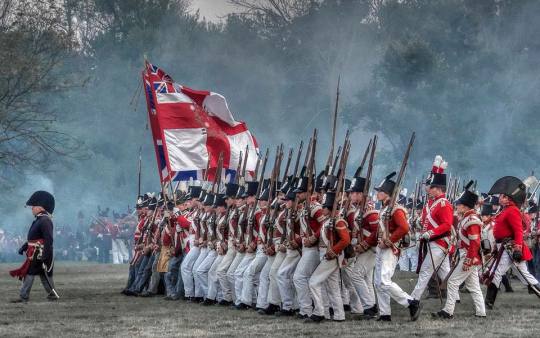
The 41st Regiment of Foot.
20 notes
·
View notes
Text
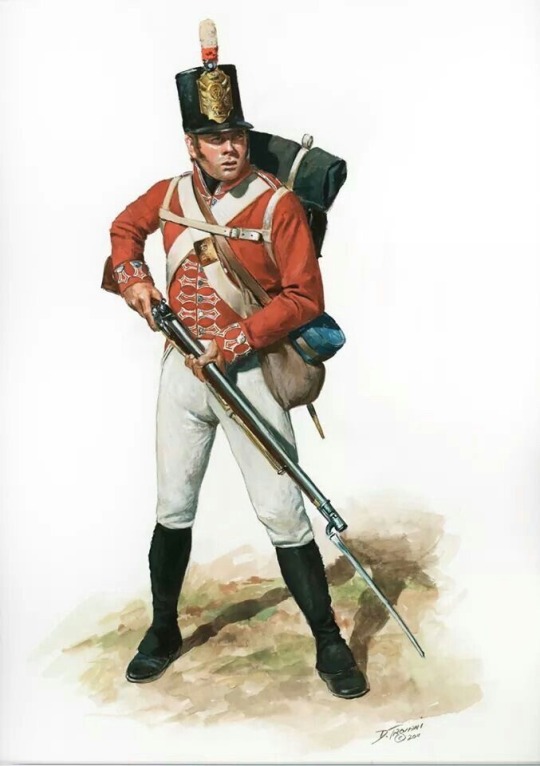
A soldier of the 41st Regiment of Foot as he would have appeared in 1812. The 41st was primarily recruited in the Northern Irish province of Ulster, and was stationed to the Canadian frontier. They fought bravely, though were known for a high rate of desertion to the American side of the line prior to the war. Many of these veterans would be resettled in Canada following the end of the Napoleonic Wars in 1815. The Bathurst plan resettled thousands of Scottish and Irish families in Upper Canada in the decades following the war, starting with former soldiers and their families. This would provide a new spark in the genesis of modern Canada.
45 notes
·
View notes
Photo
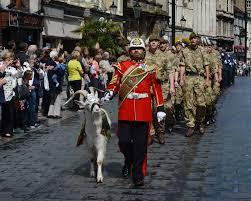
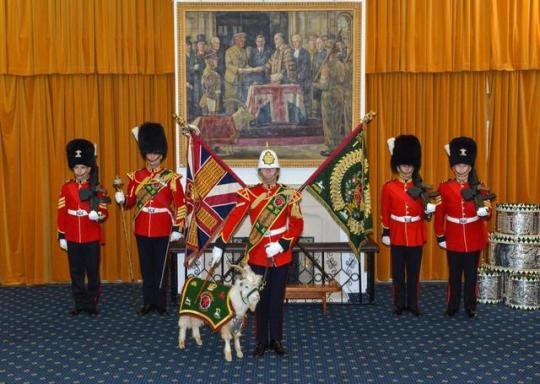
7th September 2019 - Today in Cardiff, The Royal Welsh Regiment will celebrate their 300th anniversary.
Raised in 1719, they were originally known as The 41st (Welch) Regiment of Foot. It is both the oldest and most decorated regiment of the British Army
GWELL ANGAU NA CHYWILYDD - DEATH RATHER THAN DISHONOUR
37 notes
·
View notes
Text
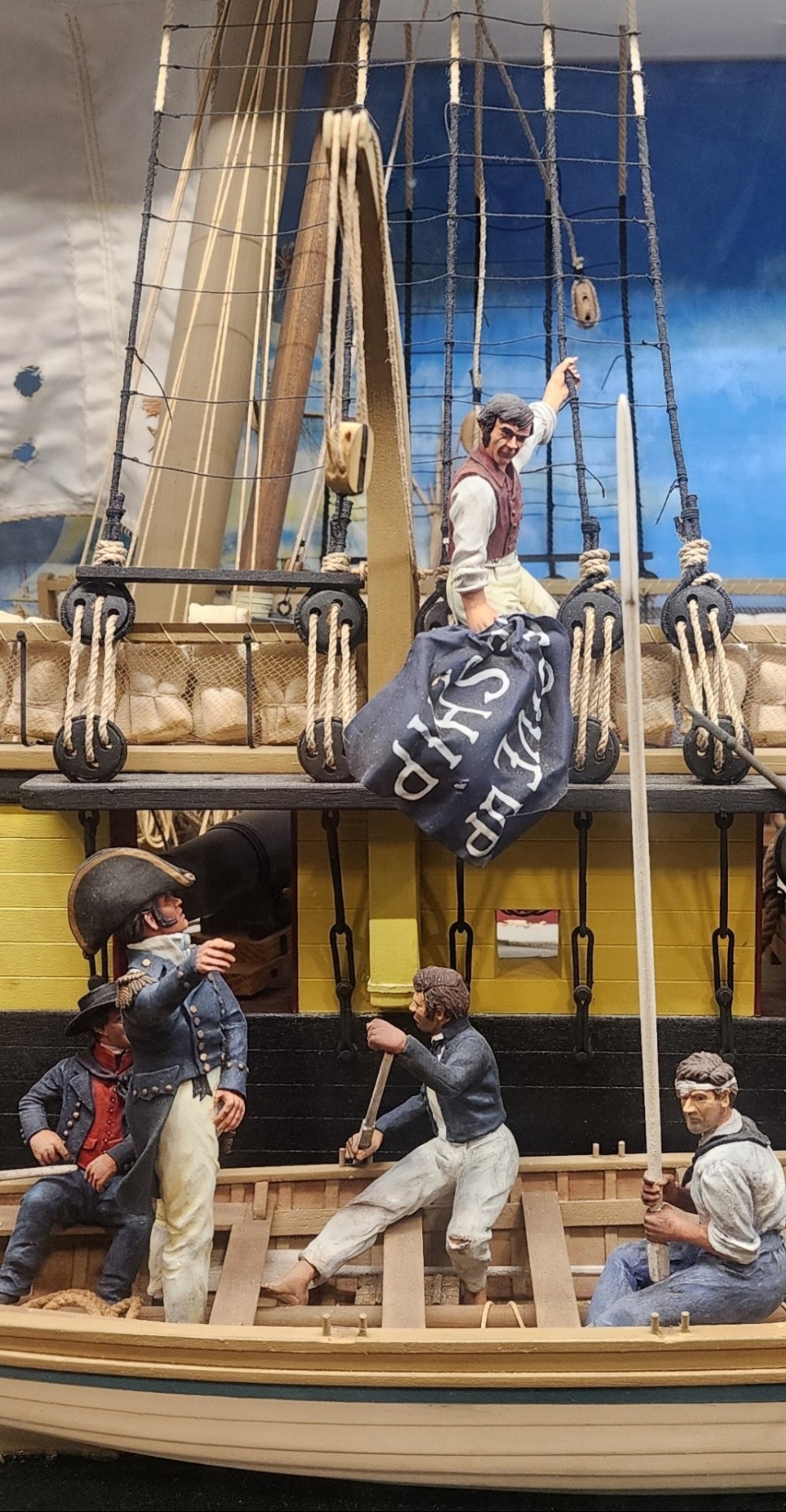

I got a sneak peek at exhibits under construction at River Raisin National Battlefield Park! They have some very impressive things in the works, but dioramas will always have my heart.
#war of 1812#age of sail#military history#oliver hazard perry#redcoats#napoleonic#battle of lake erie#battle of the thames#diorama#river raisin battlefield national park#someone please ask for more diorama pictures so i have an excuse to share them#41st regiment of foot#dressed to kill
23 notes
·
View notes
Text
Imperial Sentinel Walker

The Sentinel is a one-man, all-terrain, lightweight, bipedal combat walker that is used by the various regiments of the Imperial Guard. The Sentinel is most favored when Guard patrols must move across rough terrain that would completely immobilize heavier vehicles. The Sentinel uses a robust and highly sophisticated gyro-stabilizer system that keeps the walker steady while traversing any terrain, including steep slopes and deep craters. The articulated legs of the Sentinel allow the walker to stalk quietly through urban ruins or dense undergrowth while still allowing it to achieve an impressive speed over open ground. Scout Sentinels have noise-reduction modifications applied to their power-plants to reduce the possibility of their movements being heard by the enemy. The crews of Sentinel squads will adapt their vehicles for all sorts of difficult operating environments, making use of everything from large chainsaws for cutting through dense jungles and forests to servo-claw spikes that can grip glacial planes. Sentinels are often fielded in squadrons as scouts or infantry fire support vehicles. They can carry a variety of heavy weapons and bring high levels of power and maneuverability together in one highly mobile unit. Sentinels are lightly armoured, however, and are susceptible to heavy barrages of small arms fire. Sentinel pilots are often loners and outcasts in their regiments and are usually considered to skirt the borderline of insolence by Guard officers. Some Sentinels may be better armoured than the norm and are fitted with stabilizers to let them carry heavier weaponry. This transforms the Sentinel's role in an Imperial Guard regiment from one of armed reconnaissance and light infantry support to one of full-on artillery support.
Armament
The Imperial Sentinel can be armed with a wide variety of weapons. The original Sentinel design called for a completely open canopy and an Assault Cannon as the walker's standard armament, but eventually this design fell out of use in place of more common weaponry and an armoured or partially armoured canopy. In the late 41st Millennium the Imperial Guard usually equips its Sentinels with whichever weapons are most tactically useful for a given mission or campaign, but some regiments use their own standard pattern of Sentinel. The most common armament of the Sentinel originates on the Forge World of Mars and carries a Multi-Laser, with a partially armoured canopy and this Mars Pattern Sentinel is used by regiments across the Imperium. Sentinels can also be equipped with Autocannons, Lascannons, Rocket Launchers, Multi-Meltas, Heavy Flamers, Plasma Cannons, and Heavy Bolters. The heavy fire support variant of the Sentinel can be equipped with a Multi-Rocket Pod or Missile Launcher Pod. All Sentinels can be outfitted with Camouflage Netting, Searchlights, and Smoke Launchers. Sentinels equipped with fully armoured canopies have additional gyro-stabilizers which allow them to carry and fire heavier weapons, as well as Auspex arrays that are used to equip a powerful Hunter-Killer Missile Launcher that allows the Sentinel to serve in an anti-armour role.
Known Formations
Emperor's Shield Infantry Platoon - An Emperor's Shield Infantry Platoon is a formation used by the Imperial Guard that consists of an Infantry Platoon on foot with the support of between one to three squadrons of Scout or Armoured Sentinels. Three Emperor's Shield Infantry Platoons can be combined to form an Emperor's Shield Infantry Company
Emperor's Talons Recon Company - An Emperor's Talons Recon Company is a Sentinel formation that consists of three squadrons of Sentinels, of any type, and a single formation leader, also of any type. The Sentinel formation leader is often a combat-hardened veteran, and he and his reconnaissance company are usually tasked with hunting down a specific enemy unit and destroying it. These Sentinels stalk their prey relentlessly, carefully crossing the battlefield and emerging from the shadows to strike down their target with the utmost efficiency.
Armageddon Stompa Hunters - Traditionally, the Sentinel is considered ill-suited to deal with enemy super-heavy, Titan-class war engines, being completely outgunned and out-classed in almost every regard. However, when Armoured Sentinels are organised into large hunting packs, usually consisting of up to five Armoured Sentinels, they are capable of producing a torrent of firepower that can topple giants. The Armoured Sentinel formations that roam the Ash Wastes of Armageddon are the most illustrious of this breed. These Sentinels are armed with powerful anti-armour weapons, such as Lascannons and Plasma Cannons.
Known Sentinel Variants
There are multiple known variants and patterns of the Sentinel, and each one presents a different combination of primary weapon, pilot protection, and operational role on the battlefield. The known variants include:
Scout Sentinel - The Scout Sentinel has a partially armoured canopy and is used mainly for scouting and reconnaissance purposes. These Sentinels are usually armed with either Multi-Lasers or Heavy Flamers.
Armoured Sentinel - The Armoured Sentinel has a fully enclosed, heavily-armoured canopy and is equipped with additional gyro-stabilizers in order to carry and fire heavier weapons such as Lascannons and Autocannons.
Drop Sentinel - The Drop Sentinel has a modified engine and a modified canopy in order to fit inside of the Valkyrie Assault Carrier. Two Drop Sentinels can be carried by the Valkyrie Sky Talon and dropped into a combat zone. The Sentinels are dropped from a low altitude and use grav-chutes in order to make a soft landing. These Sentinels are usually armed with either a Heavy Bolter, Heavy Flamer or a Multi-Melta. They are most commonly used as fire support by regiments of the Elysian Drop Troops.
Support Sentinels - Support Sentinels are used as support units for armoured companies and fire support for infantry regiments. These Sentinels are usually equipped with either a Multi-Rocket Pod or a Missile Launcher Pod.
Sentinel Power-lifter - The Sentinel Power-lifter is a logistics platform and is equipped with two large power claws that are used to grip and hold heavy objects like missiles and other ordnance and transport them short distances or lift them into place. However, the power claws can be used as extremely effective melee weapons against enemy infantry in extreme circumstances.
Known Sentinel Patterns
Armageddon Pattern - The Armageddon Pattern Sentinel is armed with a Lascannon, one of the most effective anti-tank weapons the Imperial Guard possesses, and this pattern is used in a very effect anti-armour role. The canopy is also fully enclosed with armour plating.
Cadian Pattern - The Cadian Pattern Sentinel is armed with an Autocannon which is effective against more "elite" armoured infantry units and standard vehicles. Its canopy is fully enclosed and armoured.
Catachan Pattern - The Catachan Pattern Sentinel is armed with a Heavy Flamer and Chainsword for use in the dense jungles of the Death World of Catachan and planets with similar tropical environments. This pattern is both highly effective at clearing a path through heavy jungle terrain as well as decimating lightly armoured troops. In accordance with Catachan Jungle Fighters combat doctrine, most Catachan Pattern Sentinels are extremely well camouflaged. The canopy of the Catachan Sentinel is only partially armoured, but it is covered in camouflaged netting in order to better blend in with its surroundings.
Elysian Pattern - The Elysian Pattern Sentinel is armed with either a Multi-melta or a Heavy Bolter. The Multi-melta variant is used by the regiments of the Elysian Drop Troops as a substitute for more heavily armed and armored vehicles such as the Leman Russ main battle tank that is not used by the Elysians in their role as light infantry. The Elysian Pattern Sentinel's main weapon is extremely effective against even the most heavily armoured vehicles. The Heavy Bolter variant of this pattern is used to mow down densely-packed infantry formations, and is vital to the Elysians when they are operating against a larger force of infantry. Both variants of this pattern have been modified to fit inside a Valkyrie and are fitted with grav-chutes, so they can be "parachuted" into combat alongside Elysian troops as the engines and canopy of this Sentinel has been downsized in order to fit inside of a Valkyrie. The canopy is only partially armoured.
Mars Pattern - The Mars Pattern Sentinel is armed with a Multi-Laser which is effective against infantry formations and lightly armored vehicles. This pattern uses a partially armoured canopy.
Praetorian Pattern - The Praetorian Pattern Sentinel is quite a different beast compared to its brethren. The main differences include the removal of almost the entire canopy and a simpler walking mechanism. The legs of the Praetorian Pattern have one less knee joint compared to other patterns and are covered in thick plate armour. This is in accordance with Praetorian combat doctrine, which is heavily focused around lines of infantry, in countless ranks, firing in massed volleys, supported by heavy weapons teams. The Praetorian Pattern Sentinel compliments this strategy by acting as a mobile heavy weapon team, rather than a fast attack or recon vehicle. This pattern has been known to mount Punisher Assault Cannons as its primary armament.
Tallarn Pattern - The Tallarn Pattern Sentinel is armed with a Multi-Laser. It has larger feet than the other Sentinel patterns to provide better balance on the loose sand of the battle zones it is used in. It normally is manufactured with only a partially armoured canopy.
Source: http://warhammer40k.wikia.com
#warhammer 40k#horus heresy#adeptus astartes#adeptus mechanicus#adeptus arbites#adeptus custodes#adepta sororitas#astra militarum#Adeptus Astra Telepathica#officio assassinorum
27 notes
·
View notes
Photo

My Militarum Tempestus Scions. Colours based on The War of 1812, 41st Regiment of Foot. 🖌🖌🖌😃 (at Kitchener, Ontario) https://www.instagram.com/p/BtoeOnJH7bc/?utm_source=ig_tumblr_share&igshid=37rf5iw61usf
0 notes
Text
Japanese soldiers killed in WWII remembered
#PHnews: Japanese soldiers killed in WWII remembered
SURIGAO CITY – Local officials and representatives of various sectors here joined veterans of World War II in remembering the Japanese soldiers who perished in the area. The laying of wreath and prayer ceremonies at the Japanese Cremation Site inside the Surigao del Norte National High School (SNNHS) ground on Thursday morning were part of the three-day commemoration of the Battle of Surigao Strait that took place 75 years ago. The activity was graced by commander Michinori Fukuda, the Assistant Attache of the Embassy of Japan in the Philippines, and Capt. Takeshi Ishida, a retired pilot who now heads the Japanese Association in Cebu. Commander Fukuda is regarded as “the first Japanese soldier in uniform to set foot in Surigao City after World War II.” Retired Royal Adm. Guy Richmond Griffiths of HMAS Shropshire, one of the gun cruisers who engaged the Japanese Navy during the Battle of Surigao Strait, and Australian World War II veteran David Henry Mattiskie, were also present during the commemoration. Griffiths is now 97 years of age while Mattiskie is 96. More than 500 dead bodies of Japanese soldiers and Navy personnel were cremated in the site during the war. The spot was chosen because it was less vulnerable to the attacks of Surigao guerilla resistant fighters and close to the headquarters of the 3rd Battalion of the 41st Infantry Regiment of the 30th Division of the Japanese Army under the command of Lt. Gen. Gyosaku Morozumi. The Japanese soldiers and Navy personnel were killed during the successive air raids in Surigao City on Sept. 4, 1944, conducted by the US Navy Task Force 38 under Adm. William F. Halsey. In his message, Commander Fukuda prayed for the repose of the souls “of all who lost their lives” during the war in Surigao City. “We never forget that the peace we enjoy at this moment is the precious sacrifice of those who perished during the war,” Fukuda said. He added that Japan, since the end of the war, has taken the lessons of history deeply into its heart. “We must never repeat the devastation of war,” Fukuda said. During Thursday’s commemoration, the memorandum of agreement (MOA) between the Japanese Association of Cebu and SNNHS was signed. The MOA is a collaboration to protect and preserve the Japanese Cremation Site. (PNA)
***
References:
* Philippine News Agency. "Japanese soldiers killed in WWII remembered ." Philippine News Agency. https://www.pna.gov.ph/articles/1084087 (accessed October 25, 2019 at 01:07AM UTC+14).
* Philippine News Agency. "Japanese soldiers killed in WWII remembered ." Archive Today. https://archive.ph/?run=1&url=https://www.pna.gov.ph/articles/1084087 (archived).
0 notes
Photo
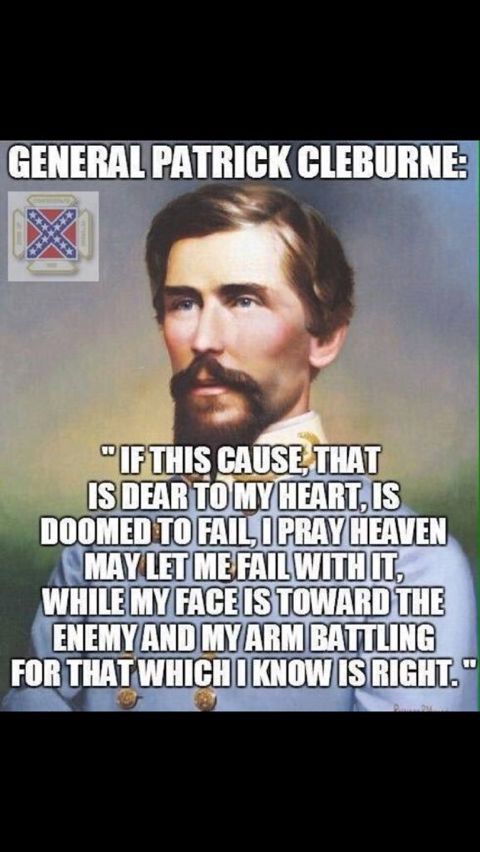
IF THE WORD DUTY WAS EVER PERSONIFIED, Major General Patrick Ronayne Cleburne was the carrying vessel. Do you admire individuals who carry deep convictions? How about one who exemplified his convictions in action, while also accepting the repercussions both good and bad? Patrick Cleburne's is an intriguing story of an Irish Immigrant who struggled in sheer determination to make his way in life. Cleburne rises through the military ranks as a non West Point Graduate to become a gallant Major General whose men adored him. This is a true story of what hard work and determination can accomplish. Patrick Cleburne was born in Ovens, County Cork, Ireland, on March 16, 1828, at Bride Park Cottage to Joseph Cleburne, a doctor, and Mary Anne Ronayne Cleburne. He was the third child and second son of a Protestant, middle-class family that included 2 brothers and a sister. His mother died when he was eighteen months old His father remarried Isabella Stewart and there were three half-siblings born to this union: Isabella, Robert, and Christopher. At age eight, the family moved to Grange Farm, near Ballincollig. While residing their Cleburne attended Church of Ireland Reverend William Spedding’s boarding school. His father would pass away unexpectedly of typhus in November 1843, having contracted it from a patient. “Ronayne,” as the family called him, was expected to carry on in the family profession of medicine. Cleburne's formative years while a child in Ireland were critical in the formation of a very grim and determined man. 19th century Ireland was a land ruled by feudal landlords who would drive their non rent paying tenants away with the bayonet. He attempted to become a physician and apprenticed for two years in an apothecary. When he failed the entrance exam at Trinity College, Dublin, he could not dare to face his family. Thus he enlisted in the 41st Foot in the British army. He found army life in Dublin to be extremely mundane. For three and a half years, Cleburne was posted at a barracks in famine-stricken Ireland. He served during the turbulent months of the 1848 Young Ireland Rebellion and was promoted to corporal on July 1, 1849. The 1840s were years of extreme political and social unrest in Ireland. The crisis deepened after the Irish potato crop failed in 1846. Relations between landlords and tenant laborers deteriorated quickly. Laborers, who usually paid in potatoes, could not pay their rents. Landlords then demanded cash for rent, but with no crop to sell landlords had no cash. It was a vicious cycle that erupted in widespread violence. Hungry, desperate laborers revolted and some landlords were murdered. Cleburne’s regiment was assigned to assist local police in evicting tenants that could not pay. He found himself in the position of guarding food from his fellow countrymen to protect his own social class and the oppressive English government. The famine continued and thousands died in poverty in their homes, by the roadside and in the streets. It is estimated that up to 500 people died in Cork City per week, Food riots and looting increased. Cleburne returned home to find his own family farm in arrears for six months rent. On September 22, 1849, he paid £20 for his discharge from the army and received his papers. In the space left on the discharge for a statement of character was written, “A good soldier.” Cleburne kept the paper for the rest of his life. Cleburne and his family decided to journey to a new life in America in the decade before The American Civil War. Cleburne loved his new country. His family would split up as job opportunity presented soon after arrival in America. Patrick would eventually land in frontier Helena Arkansas poulation 600. Just months later he learned that two physicians in Helena, Arkansas Hector Grant and Charles Nash needed a druggist to manage their store. Nash told Cleburne they needed a competent prescriptionist who could manage the entire shop. In a month, Cleburne had brought complete order to and become the manager of the Grant and Nash Drugstore. As compensation he received $50 a month, a room in the back of the shop, and meals he took with Dr. Grant. He would eventually through grit and diligence earn his way to become a full partnered small businessman. He then dedicated himself to the study of becoming a lawyer. He would soon after be selected a delegate to the Democratic Convention in 1858. Cleburne never owned slaves and often voiced his opposition to the institution. Yet he strongly valued the right and desire of a section of the country to govern itself. Once the American Civil War begins, Cleburne joins the Confederacy purely out of an adoration and loyalty for a society that accepted him and simply gave him a chance. Much of his philosophy was based on witnessing the Irish fight for independence in his homeland. After enlisting He quoted; "If this [Confederacy] that is so dear to my heart is doomed to fail, I pray heaven may let me fall with it, while my face is toward the enemy and my arm battling for that which I know to be right.” Sadly, that wish would tragically be fulfilled. The Yell Rifles were formed in the state to become part of the First Arkansas Volunteer Infantry Regiment. Cleburne was elected it's colonel. The First Arkansas was attached to the Army of Tennessee, the main Confederate force in the western theater. Cleburne was promoted to brigadier general in March 1862, and participated in the Battle of Shiloh in April and in the 1862 Kentucky Campaign. At the Battle of Richmond, Kentucky, on August 30, Cleburne was struck in the face by shrapnel and forced to leave the field. He remained away from the army until his recovery six weeks later, He returned to duty for the Battle of Perryville in October. On December 14, 1862, he was promoted to major general. He then commanded at Stones River. During 1863, Cleburne participated in major battles at Chickamauga and Missionary Ridge. On November 27, 1863, his division made a critical stand at Ringgold Gap, Georgia, while as the rearguard protecting the retreating Confederate army. His scant division of 4,000 men managed to fiercely hold back 15,000 of General Joseph Hooker’s Union troops. Cleburne received a Congressional citation from the Confederate Government for his brilliant performance. On January 2, 1864, Cleburne made his most controversial decision ever. He gathered the corps and division commanders in the Army of Tennessee to present a very radical yet extreemely logical proposal. The Confederacy was unable to fill its ranks due to a lack of manpower. Cleburne's correct yet politically charged "Memorial" was designed with the idea to arm the southern slaves for Confederate military service in exchange for their freedom. It was most thoughtfully and brilliantly crafted. However the proposal was not well received at all. Most knew that it was a political time bomb that would stir great controversy. In fact, Jefferson Davis directed that the proposal be suppressed. It was met with so much controversy that it virtually scuttled any chance of Cleburne's further promotion in the ranks. Here is a copy of the full text: Commanding General, The Corps, Division, Brigade, and Regimental Commanders of the Army of Tennessee General:
Moved by the exigency in which our country is now placed we take the liberty of laying before you, unofficially, our views on the present state of affairs. The subject is so grave, and our views so new, we feel it a duty both to you and the cause that before going further we should submit them for your judgment and receive your suggestions in regard to them We therefore respectfully ask you to give us an expression of your views in the premises. We have now been fighting for nearly three years, have spilled much of our best blood, and lost, consumed, or thrown to the flames an amount of property equal in value to the specie currency of the world. Through some lack in our system the fruits of our struggles and sacrifices have invariably slipped away from us and left us nothing but long lists of dead and mangled. Instead of standing defiantly on the borders of our territory or harassing those of the enemy, we are hemmed in to-day into less than two-thirds of it, and still the enemy menacingly confronts us at every point with superior forces. Our soldiers can see no end to this state of affairs except in our own exhaustion; hence, instead of rising to the occasion, they are sinking into a fatal apathy, growing weary of hardships and slaughters which promise no results. In this state of things it is easy to understand why there is a growing belief that some black catastrophe is not far ahead of us, and that unless some extraordinary change is soon made in our condition we must overtake it. The consequences of this condition are showing themselves more plainly every day; restlessness of morals spreading everywhere, manifesting itself in the army in a growing disregard for private rights; desertion spreading to a class of soldiers it never dared to tamper with before; military commissions sinking in the estimation of the soldier; our supplies failing; our firesides in ruins. If this state continues much longer we must be subjugated. Every man should endeavor to understand the meaning of subjugation before it is too late. We can give but a faint idea when we say it means the loss of all we now hold most sacred — slaves and all other personal property, lands, homesteads, liberty, justice, safety, pride, manhood. It means that the history of this heroic struggle will be written by the enemy; that our youth will be trained by Northern school teachers; will learn from Northern school books their version of the war; will be impressed by all the influences of history and education to regard our gallant dead as traitors, our maimed veterans as fit objects for derision. It means the crushing of Southern manhood, the hatred of our former slaves, who will, on a spy system, be our secret police. The conqueror’s policy is to divide the conquered into factions and stir up animosity among them, and in training an army of negroes the North no doubt holds this thought in perspective. We can see three great causes operating to destroy us: First, the inferiority of our armies to those of the enemy in point of numbers; second, the poverty of our single source of supply in comparison with his several sources; third, the fact that slavery, from being one of our chief sources of strength at the commencement of the war, has now become, in a military point of view, one of our chief sources of weakness.
The enemy already opposes us at every point with superior numbers, and is endeavoring to make the preponderance irresistible. President Davis, in his recent message, says the enemy “has recently ordered a large conscription and made a subsequent call for volunteers, to be followed, if ineffectual by a still further draft.” In addition, the President of the United States announces that “he has already in training an army of 100,000 negroes as good as any troops,” and every fresh raid he makes and new slice of territory he wrests from us will add to this force. Every soldier in our army already knows and feels our numerical inferiority to the enemy. Want of men in the field has prevented him from reaping the fruits of his victories, and has prevented him from having the furlough he expected after the last reorganization, and when he turns from the wasting armies in the field to look at the source of supply, he finds nothing in the prospect to encourage him. Our single source of supply is that portion of our white men fit for duty and not now in the ranks. The enemy has three sources of supply: First, his own motley population; secondly, our slaves; and thirdly, Europeans whose hearts are fired into a crusade against us by fictitious pictures of the atrocities of slavery, and who meet no hindrance from their Governments in such enterprise, because these Governments are equally antagonistic to the institution. In touching the third cause, the fact that slavery has become a military weakness, we may rouse prejudice and passion, but the time has come when it would be madness not to look at our danger from every point of view, and to probe it to the bottom. Apart from the assistance that home and foreign prejudice against slavery has given to the North, slavery is a source of great strength to the enemy in a purely military point of view, by supplying him with an army from our granaries; but it is our most vulnerable point, a continued embarrassment, and in some respects an insidious weakness. Wherever slavery is once seriously disturbed, whether by the actual presence or the approach of the enemy, or even by a cavalry raid, the whites can no longer with safety to their property openly sympathize with our cause. The fear of their slaves is continually haunting them, and from silence and apprehension many of these soon learn to wish the war stopped on any terms. The next stage is to take the oath to save property, and they become dead to us, if not open enemies. To prevent raids we are forced to scatter our forces, and are not free to move and strike like the enemy; his vulnerable points are carefully selected and fortified depots. Ours are found in every point where there is a slave to set free. All along the lines slavery is comparatively valueless to us for labor, but of great and increasing worth to the enemy for information. It is an omnipresent spy system, pointing out our valuable men to the enemy, revealing our positions, purposes, and resources, and yet acting so safely and secretly that there is no means to guard against it. Even in the heart of our country, where our hold upon this secret espionage is firmest, it waits but the opening fire of the enemy’s battle line to wake it, like a torpid serpent, into venomous activity.
In view of the state of affairs what does our country propose to do? In the words of President Davis “no effort must be spared to add largely to our effective force as promptly as possible. The sources of supply are to be found in restoring to the army all who are improperly absent, putting an end to substitution, modifying the exemption law, restricting details, and placing in the ranks such of the able-bodied men now employed as wagoners, nurses, cooks, and other employe[e]s, as are doing service for which the negroes may be found competent.” Most of the men improperly absent, together with many of the exempts and men having substitutes, are now without the Confederate lines and cannot be calculated on. If all the exempts capable of bearing arms were enrolled, it will give us the boys below eighteen, the men above forty-five, and those persons who are left at home to meet the wants of the country and the army, but this modification of the exemption law will remove from the fields and manufactories most of the skill that directed agricultural and mechanical labor, and, as stated by the President, “details will have to be made to meet the wants of the country,” thus sending many of the men to be derived from this source back to their homes again. Independently of this, experience proves that striplings and men above conscript age break down and swell the sick lists more than they do the ranks. The portion now in our lines of the class who have substitutes is not on the whole a hopeful element, for the motives that created it must have been stronger than patriotism, and these motives added to what many of them will call breach of faith, will cause some to be not forthcoming, and others to be unwilling and discontented soldiers. The remaining sources mentioned by the President have been so closely pruned in the Army of Tennessee that they will be found not to yield largely. The supply from all these sources, together with what we now have in the field, will exhaust the white race, and though it should greatly exceed expectations and put us on an equality with the enemy, or even give us temporary advantages, still we have no reserve to meet unexpected disaster or to supply a protracted struggle. Like past years, 1864 will diminish our ranks by the casualties of war, and what source of repair is there left us? We therefore see in the recommendations of the President only a temporary expedient, which at the best will leave us twelve months hence in the same predicament we are in now. The President attempts to meet only one of the depressing causes mentioned; for the other two he has proposed no remedy. They remain to generate lack of confidence in our final success, and to keep us moving down hill as heretofore. Adequately to meet the causes which are now threatening ruin to our country, we propose, in addition to a modification of the President’s plans, that we retain in service for the war all troops now in service, and that we immediately commence training a large reserve of the most courageous of our slaves, and further that we guarantee freedom within a reasonable time to every slave in the South who shall remain true to the Confederacy in this war. As between the loss of independence and the loss of slavery, we assume that every patriot will freely give up the latter — give up the negro slave rather than be a slave himself. If we are correct in this assumption it only remains to show how this great national sacrifice is, in all human probabilities, to change the current of success and sweep the invader from our country.
Our country has already some friends in England and France, and there are strong motives to induce these nations to recognize and assist us, but they cannot assist us without helping slavery, and to do this would be in conflict with their policy for the last quarter of a century. England has paid hundreds of millions to emancipate her West India slaves and break up the slave-trade. Could she now consistently spend her treasure to reinstate slavery in this country? But this barrier once removed, the sympathy and the interests of these and other nations will accord with our own, and we may expect from them both moral support and material aid. One thing is certain, as soon as the great sacrifice to independence is made and known in foreign countries there will be a complete change of front in our favor of the sympathies of the world. This measure will deprive the North of the moral and material aid which it now derives from the bitter prejudices with which foreigners view the institution, and its war, if continued, will henceforth be so despicable in their eyes that the source of recruiting will be dried up. It will leave the enemy’s negro army no motive to fight for, and will exhaust the source from which it has been recruited. The idea that it is their special mission to war against slavery has held growing sway over the Northern people for many years, and has at length ripened into an armed and bloody crusade against it. This baleful superstition has so far supplied them with a courage and constancy not their own. It is the most powerful and honestly entertained plank in their war platform. Knock this away and what is left? A bloody ambition for more territory, a pretended veneration for the Union, which one of their own most distinguished orators (Doctor Beecher in his Liverpool speech) openly avowed was only used as a stimulus to stir up the anti-slavery crusade, and lastly the poisonous and selfish interests which are the fungus growth of the war itself. Mankind may fancy it a great duty to destroy slavery, but what interest can mankind have in upholding this remainder of the Northern war platform? Their interests and feelings will be diametrically opposed to it. The measure we propose will strike dead all John Brown fanaticism, and will compel the enemy to draw off altogether or in the eyes of the world to swallow the Declaration of Independence without the sauce and disguise of philanthropy. This delusion of fanaticism at an end, thousands of Northern people will have leisure to look at home and to see the gulf of despotism into which they themselves are rushing.
The measure will at one blow strip the enemy of foreign sympathy and assistance, and transfer them to the South; it will dry up two of his three sources of recruiting; it will take from his negro army the only motive it could have to fight against the South, and will probably cause much of it to desert over to us; it will deprive his cause of the powerful stimulus of fanaticism, and will enable him to see the rock on which his so-called friends are now piloting him. The immediate effect of the emancipation and enrollment of negroes on the military strength of the South would be: To enable us to have armies numerically superior to those of the North, and a reserve of any size we might think necessary; to enable us to take the offensive, move forward, and forage on the enemy. It would open to us in prospective another and almost untouched source of supply, and furnish us with the means of preventing temporary disaster, and carrying on a protracted struggle. It would instantly remove all the vulnerability, embarrassment, and inherent weakness which result from slavery. The approach of the enemy would no longer find every household surrounded by spies; the fear that sealed the master’s lips and the avarice that has, in so many cases, tempted him practically to desert us would alike be removed. There would be no recruits awaiting the enemy with open arms, no complete history of every neighborhood with ready guides, no fear of insurrection in the rear, or anxieties for the fate of loved ones when our armies moved forward. The chronic irritation of hope deferred would be joyfully ended with the negro, and the sympathies of his whole race would be due to his native South. It would restore confidence in an early termination of the war with all its inspiring consequences, and even if contrary to all expectations the enemy should succeed in over-running the South, instead of finding a cheap, ready-made means of holding it down, he would find a common hatred and thirst for vengeance, which would break into acts at every favorable opportunity, would prevent him from settling on our lands, and render the South a very unprofitable conquest. It would remove forever all selfish taint from our cause and place independence above every question of property. The very magnitude of the sacrifice itself, such as no nation has ever voluntarily made before, would appal [sic] our enemies, destroy his spirit and his finances, and fill our hearts with a pride and singleness of purpose which would clothe us with new strength in battle. Apart from all other aspects of the question, the necessity for more fighting men is upon us. We can only get a sufficiency by making the negro share the danger and hardships of the war. If we arm and train him and make him fight for the country in her hour of dire distress, every consideration of principle and policy demand that we should set him and his whole race who side with us free. It is a first principle with mankind that he who offers his life in defense of the State should receive from her in return his freedom and his happiness, and we believe in acknowledgment of this principle. The Constitution of the Southern States has reserved to their respective governments the power to free slaves for meritorious services to the State. It is politic besides. For many years, ever since the agitation of the subject of slavery commenced, the negro has been dreaming of freedom, and his vivid imagination has surrounded that condition with so many gratifications that it has become the paradise of his hopes. To attain it he will tempt dangers and difficulties not exceeded by the bravest soldier in the field. The hope of freedom is perhaps the only moral incentive that can be applied to him in his present condition. It would be preposterous then to expect him to fight against it with any degree of enthusiasm, therefore we must bind him to our cause by no doubtful bonds; we must leave no possible loop-hole for treachery to creep in. The slaves are dangerous now, but armed, trained, and collected in an army they would be a thousand fold more dangerous; therefore when we make soldiers of them we must make free men of them beyond all question, and thus enlist their sympathies also. We can do this more effectually than the North can now do, for we can give the negro not only his own freedom, but that of his wife and child, and can secure it to him in his old home. To do this, we must immediately make his marriage and parental relations sacred in the eyes of the law and forbid their sale. The past legislation of the South concedes that a large free middle class of negro blood, between the master and slave, must sooner or later destroy the institution. If, then, we touch the institution at all, we would do best to make the most of it, and by emancipating the whole race upon reasonable terms, and within such reasonable time as will prepare both races for the change, secure to ourselves all the advantages, and to our enemies all the disadvantages that can arise, both at home and abroad, from such a sacrifice. Satisfy the negro that if he faithfully adheres to our standard during the war he shall receive his freedom and that of his race. Give him as an earnest of our intentions such immediate immunities as will impress him with our sincerity and be in keeping with his new condition, enroll a portion of his class as soldiers of the Confederacy, and we change the race from a dreaded weakness to a position of strength.
Will the slaves fight? The helots of Sparta stood their masters good stead in battle. In the great sea fight of Lepanto where the Christians checked forever the spread of Mohammedanism over Europe, the galley slaves of portions of the fleet were promised freedom, and called on to fight at a critical moment of the battle. They fought well, and civilization owes much to those brave galley slaves. The negro slaves of Saint Domingo, fighting for freedom, defeated their white masters and the French troops sent against them. The negro slaves of Jamaica revolted, and under the name of Maroons held the mountains against their masters for 150 years; and the experience of this war has been so far that half-trained negroes have fought as bravely as many other half-trained Yankees. If, contrary to the training of a lifetime, they can be made to face and fight bravely against their former masters, how much more probable is it that with the allurement of a higher reward, and led by those masters, they would submit to discipline and face dangers.
We will briefly notice a few arguments against this course. It is said Republicanism cannot exist without the institution. Even were this true, we prefer any form of government of which the Southern people may have the molding, to one forced upon us by a conqueror. It is said the white man cannot perform agricultural labor in the South. The experience of this army during the heat of summer from Bowling Green, Ky., to Tupelo, Miss., is that the white man is healthier when doing reasonable work in the open field than at any other time. It is said an army of negroes cannot be spared from the fields. A sufficient number of slaves is now administering to luxury alone to supply the place of all we need, and we believe it would be better to take half the able-bodied men off a plantation than to take the one master mind that economically regulated its operations. Leave some of the skill at home and take some of the muscle to fight with. It is said slaves will not work after they are freed. We think necessity and a wise legislation will compel them to labor for a living. It is said it will cause terrible excitement and some disaffection from our cause. Excitement is far preferable to the apathy which now exists, and disaffection will not be among the fighting men. It is said slavery is all we are fighting for, and if we give it up we give up all. Even if this were true, which we deny, slavery is not all our enemies are fighting for. It is merely the pretense to establish sectional superiority and a more centralized form of government, and to deprive us of our rights and liberties. We have now briefly proposed a plan which we believe will save our country. It may be imperfect, but in all human probability it would give us our independence. No objection ought to outweigh it which is not weightier than independence. If it is worthy of being put in practice it ought to be mooted quickly before the people, and urged earnestly by every man who believes in its efficacy. Negroes will require much training; training will require much time, and there is danger that this concession to common sense may come too late.
P. R. Cleburne, major-general, commanding division D. C. Govan, brigadier-general John E. Murray, colonel, Fifth Arkansas G. F. Baucum, colonel, Eighth Arkansas Peter Snyder, lieutenant-colonel, commanding Sixth and Seventh Arkansas E. Warfield, lieutenant-colonel, Second Arkansas M. P. Lowrey, brigadier-general A. B. Hardcastle, colonel, Thirty-second and Forty-fifth Mississippi F. A. Ashford, major, Sixteenth Alabama John W. Colquitt, colonel, First Arkansas Rich. J. Person, major, Third and Fifth Confederate G. S. Deakins, major, Thirty-fifth and Eighth Tennessee J. H. Collett, captain, commanding Seventh Texas J. H. Kelly, brigadier-general, commanding Cavalry Division Patrick Cleburne was a very shy and unassuming figure with a quiet determined inner drive. Yet he carried an undeniable emanation of authority and competence about him. He was extremely introverted, often avoiding social situations. He was extremely shy around women. That would change abruptly on January 13, 1864. Cleburne acted as best man at the wedding of close friend and superior commander William Hardee to Mary Lewis Forman near Demopolis, Alabama. There he first laid eyes on twenty-four year old Susan Tarleton, maid of honor to her best friend, “Mollie” Lewis. The wedding guests left the next morning by steamboat for Mobile, where Cleburne spent the remainder of his furlough, his first since the war began. Their he proposed to Susan only days after meeting her. She hesitated in her decision but did not discourage him. In February, he received another furlough and returned to Mobile. He later wrote to a friend, “After keeping me in cruel suspense for six weeks she has at length consented to be mine and we are engaged. I need not say how miserable this has made me.” A fall wedding seems to have been planned. Unfortunately, the war woulde come between Cleburne and Susan Tarleton after he departed Mobile in early March 1864. They would never see each other again. Like countless other soldiers and their loved ones back home, the couple tried to stay in touch by mail. The shy, formal, no-nonsense general would reveal another side of his character in his letters to Miss Tarleton. The letters, said aide Leonard Mangum, “were often revelations, even to one who knew him well, as to the depth of his feelings. Devoid of all approach to sentimentality, they were full of a most sweet and tender passion." Before the tragic and fatal charge at the bloody Battle of Franklin Tennessee that Cleburne seemed to know would be his last he reluctantly but bravely did his duty. Despite seeing the futility of a successful assault, he accepted his final order, stating to his superior commander Lt. General John Bell Hood, "I will take the enemy's works or fall in the attempt." His closest aide stated, "Well General there will not be many of us that get back to Arkansas." Cleburne's response: "Well Govan, if we are to die, then let us die like men." Govan would survive the blody morass to see Arkansas once again. But by that day’s end, in the words of his former Adjutant Captain Irving A. Buck, ‘the inspiring voice of Cleburne was already hushed in death’ Cleburne rode to a site called Breezy Hill just before deployment of his division and surveyed the Union defenses down on the Harpeth River that flowed through the once sleepy town of Franklin. As he peered through a borrowed snipers telescope he spoke aloud to no one in particular, "They have three lines of works." "And they are all completed." "They are most formidable." Cleburne advanced on horseback in a charge with his men directly into the center of the Union Line. The horse that bore him was shot from under him. Asking to borrow another, Cleburne placed his feet in the stirrups to mount just as that animal was struck by a cannonball and killed. Cleburne drew his sword and charged on foot at the center of the line where he could see the Bonnie Blue Flag being raised on the parapet. He was struck some 50 yards from the trench line by a bullet in the heart and died instantly. Major-General Patrick Ronanyne Cleburne's body was taken to nearby Carnton plantation. He was lain out for morning on the porch along with General John Adams, General Hiram Granbury, and General Otho Strahl, all who perished in the bloody trenches at Franklin. He was initially interred at Rose Hill near Franklin. His body was soon moved to St. John’s Church, Ashwood, Tennessee. Cleburne had passed this cemetery just days earlier during the advance into Tennessee and remarked that it was ‘almost worth dying for, to be buried in such a beautiful spot’. In 1870 his body would be moved once again for the final time, this time returning to his adopted State in Arkansas, where he remains in Maple Hill Cemetery, Helena. Back in Mobile, Susan Tarleton waited anxiously for any kind of word from the man she loved dearly. Union raiding parties had cut all telegraph lines into the city. Six days after the Battle of Franklin, as she walked in her garden she heard a passing newsboy shout: “Big battle near Franklin, Tennessee! General Cleburne killed! Read all about it.” She fainted dead away. After spending a year confined to her bedroom in “deepest mourning,” Susan Tarleton reluctantly re-entered life. In 1867 she married Captain Hugh L. Cole, a former Confederate officer and an old college friend of her brother’s. Less than a year later, she died unexpectedly of an apparent brain effusion. While growing up in Ireland Patrick Cleburne learned valuable lessons of the harsh realitys that life often presented. He also developed an incredible work ethic. While in the British army, he had learned patience, discipline, self-control, and how to live a life of self-denial. He also came to deeply appreciate the position and suffering of those at the mercy of tyrannical authority in the form of a far too powerful central government. Those lessons served him well as the leader of the men he drilled and prepared to go into battle with. Duty is not just following orders. It is seeing that some ideals and some causes are bigger than one's self, and duty in its deepest sense is the following orders that one does not always agree with. One of his closest friends, Lt Gen. William J. Hardee said of Cleburne after his death, "He was an Irishman by birth, a southerner by adoption and residence, a lawyer by profession, a soldier in the British army by accident, and a soldier in the southern armies from patriotism and conviction of duty in his manhood."
0 notes
Text
Bayonets are Trumps
On the night of December 19th, 1814, in a small hamlet named Youngston, about two miles from American-held Fort Niagara, a group of US Army officers were sheltering from the winter chill, playing cards. What they didn’t know was that British soldiers belonging to the 100th Regiment of Foot, the grenadiers and light infantry of the 41st Regiment of Foot, and some artillerymen of the Royal Artillery, were at that moment covertly approaching, having been secretly conveyed overland from Burlington and passed silently upriver towards the fort. A detachment of British soldiers had come up to the officers’ billet. One, peering through the window, overheard one of the card-players asking “what are trumps?”
“Bayonets are trumps,” screamed the British soldier as he burst in through the window and bayonetted everyone to death.
Thanks to @thepaliamentaryjacobite for bringing this darkly banterful historical account to my attention - it can be found in the Chronicles of Canada by Henry Beaumont Small.
I’m also not sure if my new tagline should be “bayonets are trumps” or “I’ll shew you a place where the streets are paved with pancakes.”
#war of 1812#1812#history#military history#british army#us army#bayonets are trumps#Napoleonic wars#napoleonic#redcoat#redcoats
31 notes
·
View notes